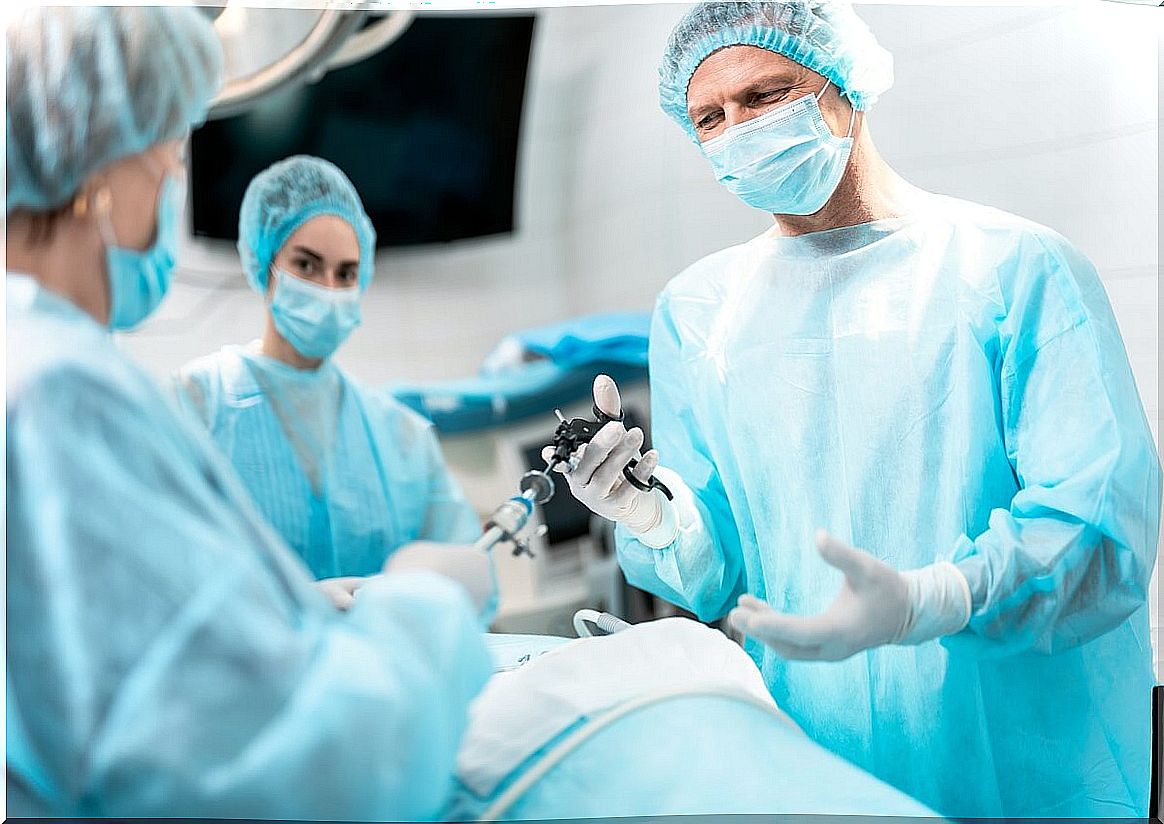Laryngectomy: Why Is It Performed And What Are The Implications?
Laryngectomy has a special impact on young people and women. The change in voice and speech gives rise to an adaptation process that is demanding and requires emotional and psychological support.

Laryngectomy is a surgical procedure in which the entire larynx is removed. This type of surgery causes great changes in those who undergo it. The most relevant are the loss of pharyngeal voice, alterations in smell, changes in breathing and changes in personal appearance.
Those who undergo a laryngectomy must have a tracheostomy for life. This is an opening in the windpipe, with a tube inserted, which facilitates the passage of air into the lungs. This implies the need for permanent care.
The effects of laryngectomy are very diverse and involve several day-to-day limitations. These types of patients must re-educate their voice and may have to deal with difficulties swallowing food and straining.
Who should have a laryngectomy?

Within the larynx there are two different routes: one leads to the stomach (esophagus) and another to the lungs (larynx and trachea). The larynx shares a common space with the esophagus called the pharynx. Laryngectomy removes the larynx and thus cuts the connection between the mouth and the lungs.
Removal of the larynx is a very severe surgery that is only carried out if there is no other alternative. When does this happen? In the following cases:
- There is severe trauma to the larynx ; that is, considerable damage caused by a gunshot wound or other such factor.
- The patient has cancer of the larynx.
- There is radiation necrosis. This is: severe damage to that area from radiation therapy.
What does the procedure consist of?
To perform laryngectomy, general anesthesia is required. The surgeon makes incisions in the neck and through them removes the larynx. In some cases, it can also remove part of the pharynx and / or lymph nodes.
After the larynx is removed, the doctor will make a hole in the front of the windpipe. This is called a “stoma” and is about the diameter of a nickel. Then a tube or cannula is inserted to connect the lungs to the outside.
At the end, a suture is made with surgical stitches. Drainage tubes are usually placed in the neck to remove fluids and blood from the operated area. Upon completion, the patient must go to a recovery room.
Sometimes a tracheoesophageal puncture (PET) is also done during laryngectomy. This is a small hole in the windpipe and esophagus. Then a valve is placed so that the hole remains open. The goal is to keep food out of the windpipe without blocking the airway.
Possible risks
All surgery carries risks. Among the most common are bleeding, infection, allergic reaction to medications, breathing problems, and heart problems. In laryngectomy in particular there are other risks, such as the following:
- Hematoma or accumulation of blood due to rupture of the thyroid arteries.
- Emergence of fistulas. That is, abnormal conduits or connections between the pharynx and the skin.
- Anastomotic stenosis. This is the name given to the condition in which the stoma opening becomes too small.
- Filtration. It occurs between the tracheostomy prosthesis and the tracheoesophageal perforation (TEP).
- Damage to the windpipe or esophagus.
- Difficulties speaking
- Difficulty swallowing food.
What should be considered before a laryngectomy?
Before laryngectomy, a series of tests and examinations should be performed. Typically, blood tests and sometimes imaging studies are ordered. The doctor will also do a complete physical exam.
The patient should consult with a swallowing therapist and a speech therapist. This will help you prepare for the changes that will follow after surgery. Likewise, you must have the advice of a nutritionist. If you are a smoker, you should quit and receive support and information to do so.
The person should tell the doctor about the drugs they are using. In addition, you must indicate if you habitually consume alcohol and, in the case of women, if there is pregnancy or the possibility of it.
To all the above, the following indications are added:
- Any medication that makes it difficult for the blood to clot should be avoided. This measurement will be taken from a week before the surgery.
- The patient should not consume food or drink for 12 hours before surgery.
- If the person has a beard or mustache, they should shave.
- Follow any other indication indicated by the doctor.
What should be considered after laryngectomy?

After performing the laryngectomy, the patient will most likely spend several days in the Intensive Care Unit (ICU). You will need to eat through a tube that runs from your nose to your stomach. You will receive oxygen through the stoma and pain relievers.
When the condition stabilizes, you will move to a hospital room. You will need to stay there for about 10 days. During that time, you will be trained to learn to speak and eat again. It will also help you get used to the new way of breathing.
After passing through the hospital, you must continue with the rehabilitation process. This includes the two basics listed below.
Stoma care
There is an opening in the stoma through which viruses and bacteria can enter with the potential to cause infection. Therefore, it is essential to learn to take care of it. The edges of it should be cleaned with water, mild soap and gauze.
Inside the stoma, scabs and mucus form. These must be removed for air to flow properly into the lungs. Sometimes it is enough to cough forcefully to eliminate these accumulations; if this is not possible, they will have to be removed manually. The person intervened must receive training for it.
It is important to have a humidifier in the home, as this prevents scabbing on the stoma. Sometimes the use of a special mask that provides humidified air is also indicated; its use is temporary.
Speech rehabilitation
Laryngectomy causes the sound of the voice to change dramatically. The air no longer circulates in the same way and this causes major changes in the way sounds are emitted. It is important to develop new ways of communicating, as well as to learn to speak again.
In principle, non-verbal communication can be used, through gestures or sign language. Some of the alternatives for speech recovery are as follows:
- Speak esophageal. It involves trapping the air from the mouth in the upper part of the esophagus and throat. Although difficult to learn, this technique can produce speech.
- Electrolarynx. It consists of the adaptation of a device to produce voice and speech. It will sound robotic, but it is easy to use and solves the problem in the short or long term.
- TEP speech. It involves connecting a voice prosthesis to the TEP valve (the one for the tracheoesophageal puncture). This is located on the stoma and allows you to speak.
Living after a laryngectomy
Every laryngectomy involves major life changes. However, with the indications of the case and a lot of perseverance , an almost normal daily life can be achieved. It is possible to breathe, speak, and eat again in a way that does not cause major discomfort.
The biggest risk is a blockage of the stoma, as this cuts off breathing. With proper training you can prevent it from happening. A person with laryngectomy requires psychological support, since they will have to face many psychosocial changes.









